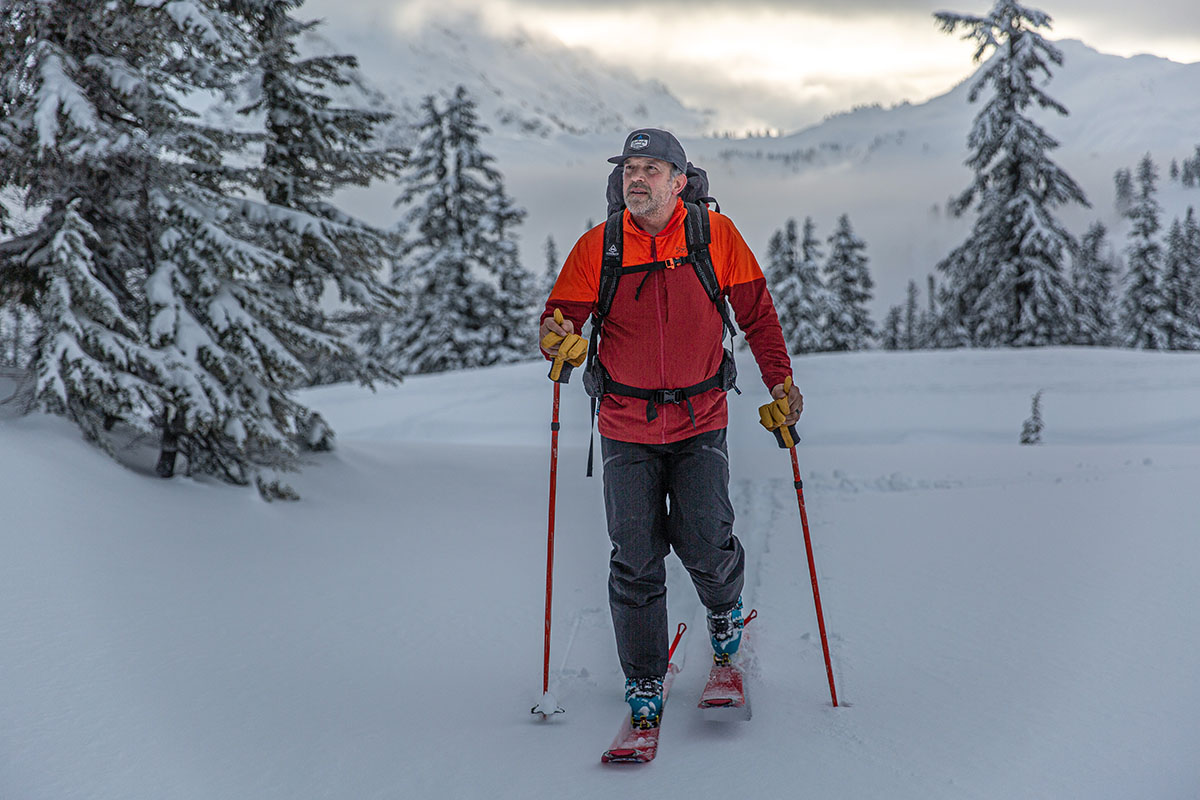
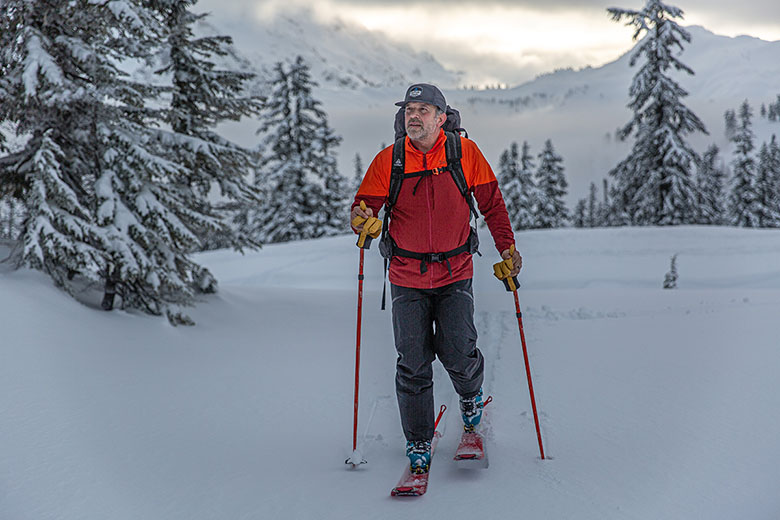
Price: $600
Weight: 1 lb. 6.2 oz. (size large)
Waterproofing: 3L Gore-Tex
What we like: Typical Arc’teryx build quality, weather protection, and attention to detail in a streamlined package.
What we don’t: Smaller-than-expected fit and very expensive.
See the Men's Arc'teryx Sabre Pant See the Women's Sentinel Pant
Arc’teryx is a leader in the premium ski kit market, and their flagship Sabre Pant was quick to win us over with its top-notch protection in a lightweight package. Whether you’re a resort rider or like to earn your turns in the backcountry, the pants are well equipped with a proven 3-layer Gore-Tex build, lightweight fleece backer for comfort, and long-lasting construction. Like most Arc’teryx gear, the Sabre Pant doesn’t come cheap at a whopping $600 and the latest version has a smaller and shorter fit than we expected, but it leaves little to be desired in terms of overall performance. Below we break down our experiences with the Sabre Pant. To see how it stacks up to the competition, see our article on the best ski pants. And to complete your kit, we've also tested and reviewed the Arc'teryx Sabre Jacket.
With a proven 3-layer Gore-Tex build and Arc’teryx’s typical suite of premium protective features, the Sabre Pant is a stalwart in wet and rowdy weather. For reference, the pants have deftly shrugged off variable coastal conditions—including wet, heavy snow and lots of rain with the occasional powder day mixed in—with no signs of wetting out to date. On one outing to Mt. Baker, we experienced extreme winds that caused the blowing snow to feel like pellets against our skin, and the Sabre did an admirable job of keeping my legs protected as we retreated to our van. The pants also have a light flannel backer that adds a small boost in both warmth and comfort, which has been a very welcome addition during long and frigid chairlift rides (more in “Comfort” below).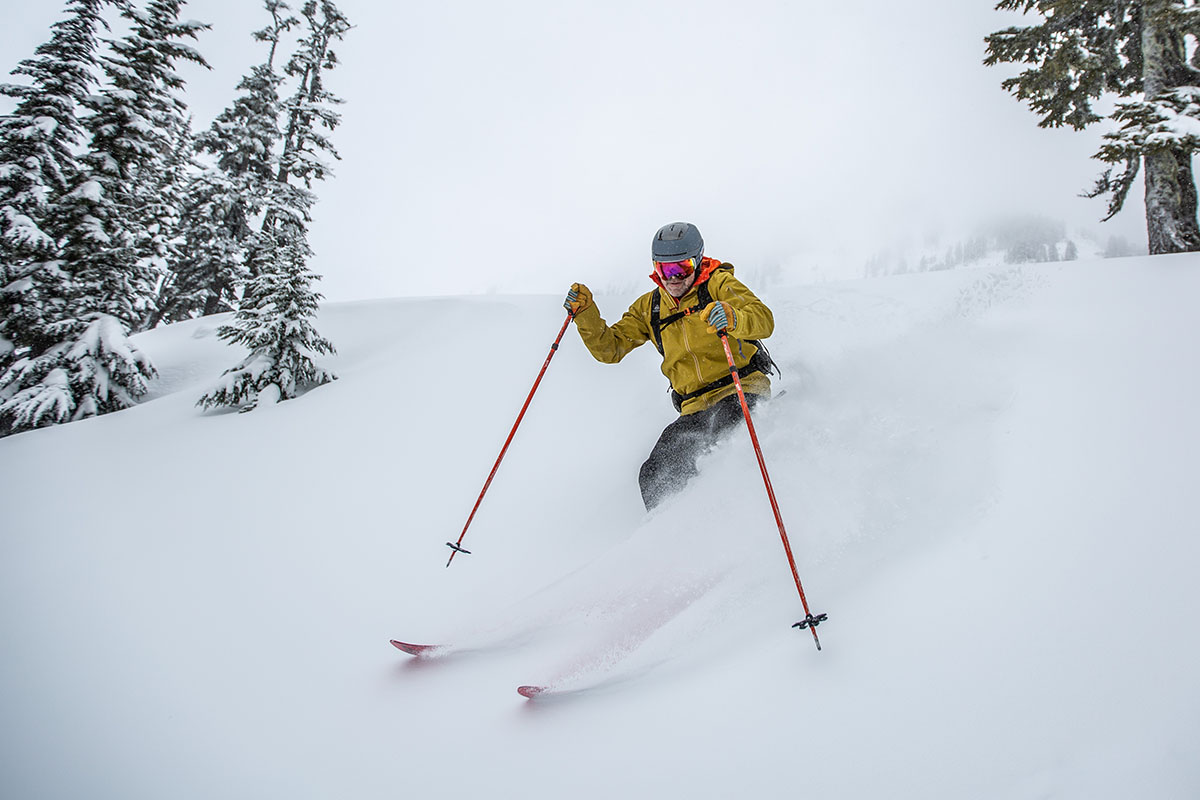
Along with its quality waterproofing, the Sabre Pant comes equipped with a nice array of protective features. For starters, the durable water repellent (DWR) finish is highly effective at keeping light precipitation at bay, prompting moisture to bead up and roll off the surface of the pants rather than soak in. Further, the integrated gaiters have been great at sealing snow out of my boots, even when I’ve sunk a foot or two into deep powder during transitions, and all of the zippers are highly water-resistant and trustworthy enough that I don’t worry about storing my phone in either of the thigh pockets. Finally, the pants are powder skirt-friendly with snaps at the back for connecting to any of Arc’teryx’s compatible ski jackets, including the matching Sabre Jacket or top-end Rush Jacket.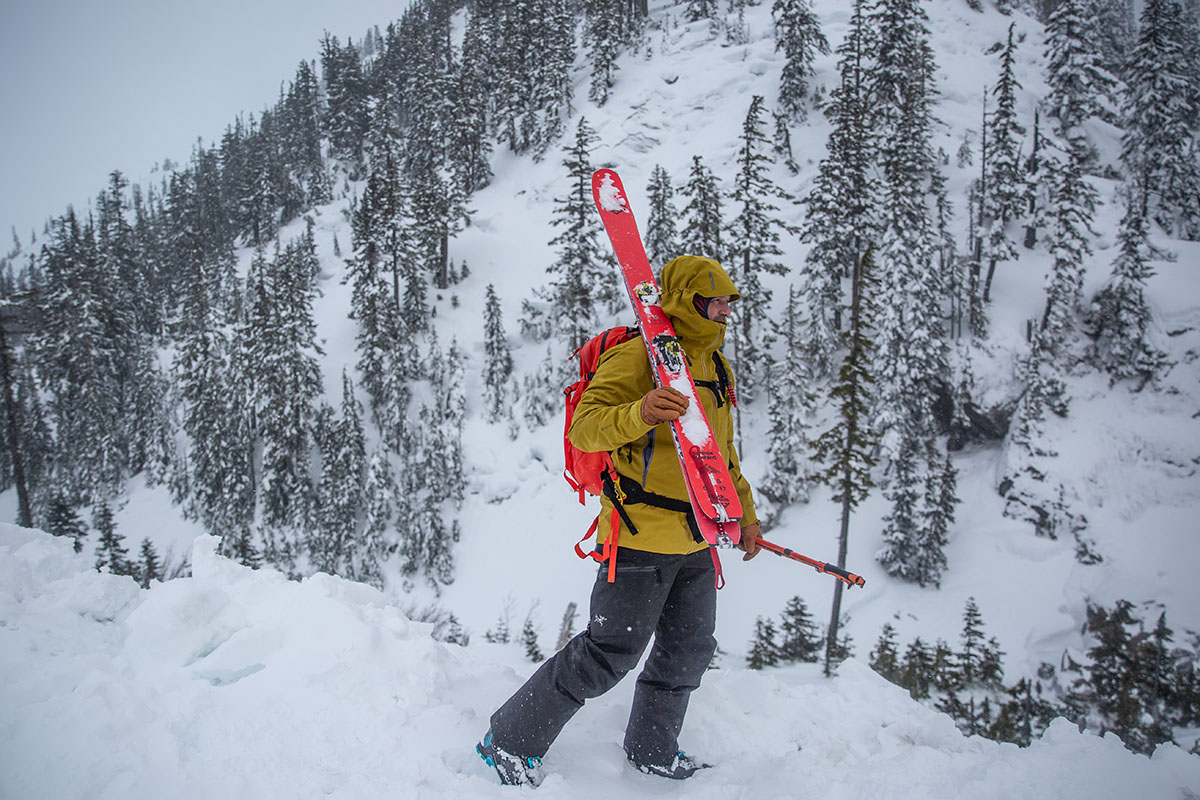
I admittedly run very warm but have managed to stay surprisingly comfortable in the Sabre Pant throughout testing. That’s not to say I haven’t grown warm while ascending—especially in the Mt. Baker Wilderness, which is known for having very steep skin tracks—but the Gore-Tex build is relatively breathable, and the waist-to-knee vents have been a lifesaver for dumping excess heat on big climbs and warmer days. For reference, with the vents open, I’ve managed to remain comfortable in a wide range of temperatures, from spring-like warmth (above freezing) to downright frigid (negative single digits Fahrenheit). It’s also worth noting that I typically prefer to wear higher-riding bibs for their added coverage and more integrated fit (you don’t have to worry about discomfort from a waistband), but there’s no question that I’m able to stay cooler in pants. 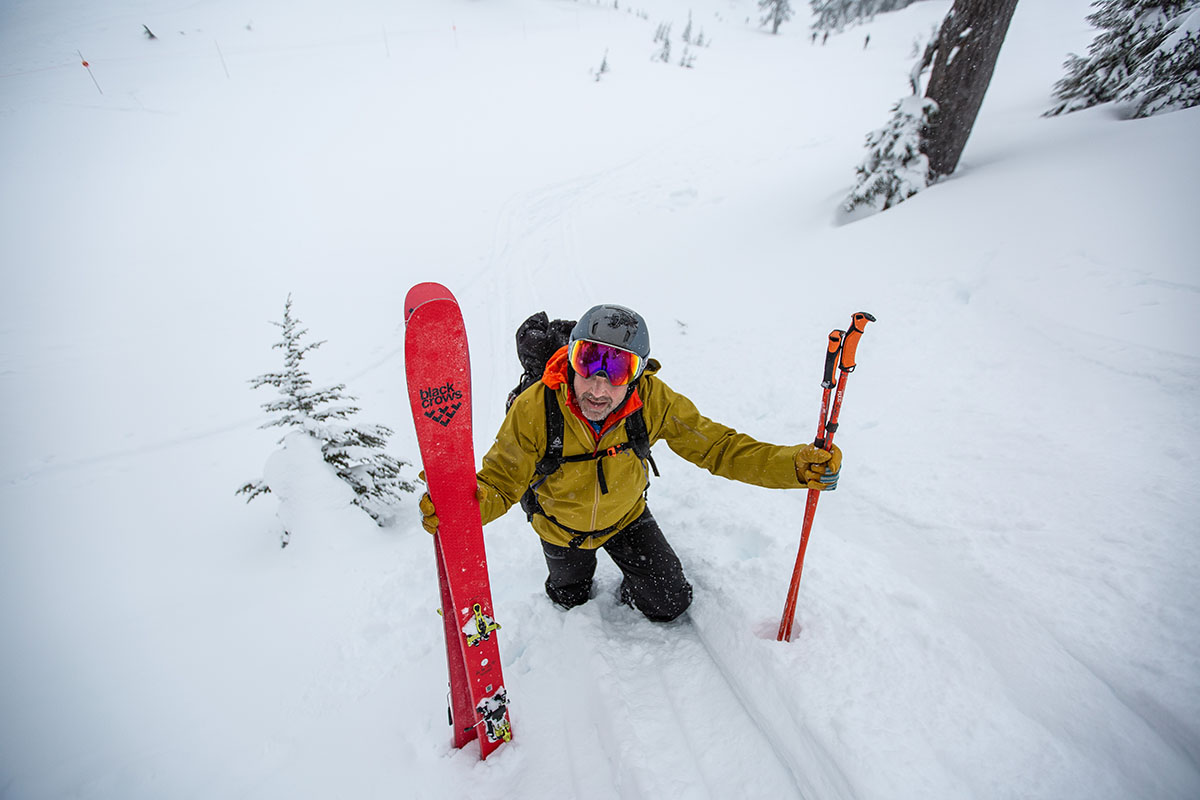
Comfort is a bit of a mixed bag with the Sabre Pant. On the bright side, the pants feature a lightweight fleece backer that’s noticeably soft and supple—a far cry from the stiff and crinkly feel common among unlined Gore-Tex designs. It also adds a touch of warmth, which has been particularly helpful on bone-chilling resort days. I should note that I always wear long underwear underneath my ski pants or bibs, so my skin rarely comes into contact with the brushed backer, but I appreciate that the pants slide easily over baselayers.
That said, I do have a couple of comfort-related gripes to report. First is the thin belt design, which tends to dig into my waist when cinched tightly. Opting for bibs would solve the issue (and Arc’teryx does make a Sabre Bib Pant), but you can also replace the belt with a thicker design to keep the pants from sagging while reducing pressure at the waist. The other issue has to do with fit: My usual size large was abnormally tight at the waist with a shorter-than-expected length and inseam. This led to some restriction and discomfort—in addition to exposing the waistband of my baselayer—when kneeling or bending over to fiddle with my boots or bindings (more in “Fit and Sizing” below).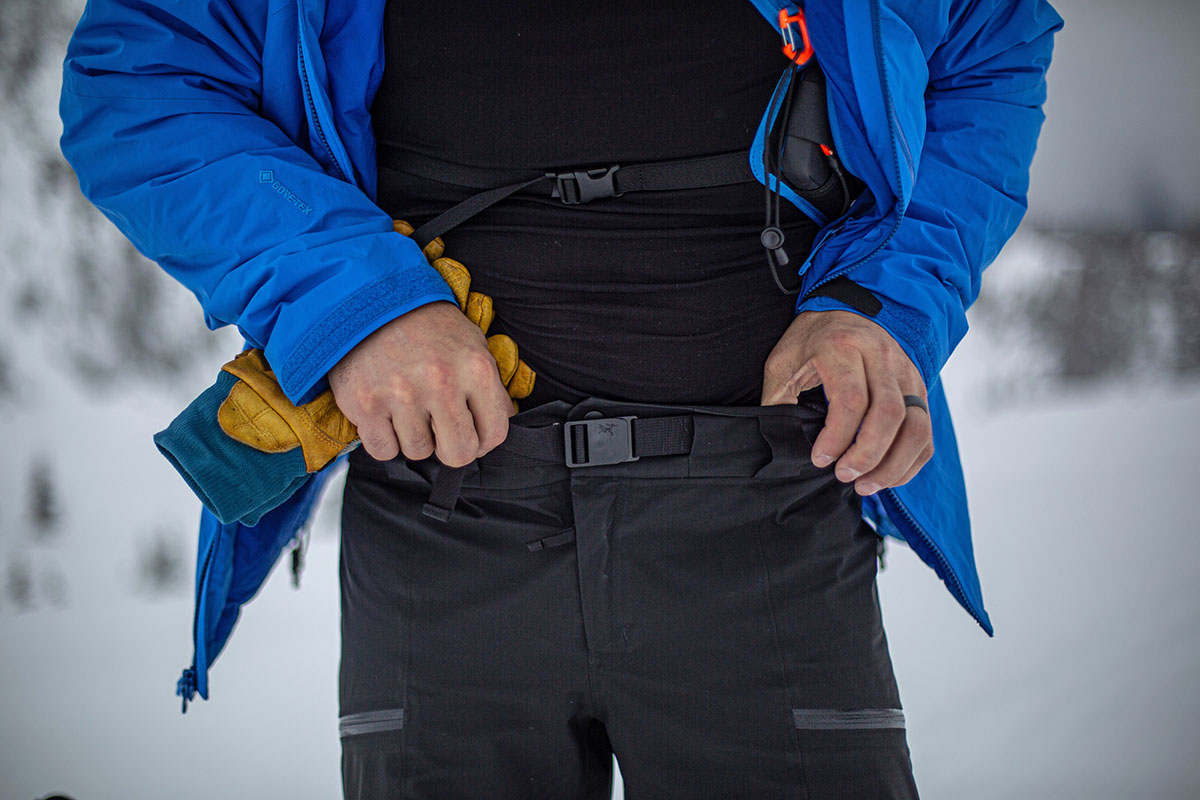
We’ve come to expect top-notch quality from Arc’teryx, and the Sabre Pant delivered in spades. The 80-denier (D) Gore-Tex build has performed flawlessly with no signs of premature wear or wetting out, and the tough Keprotec instep guards have proven to be remarkably abrasion-resistant despite my tendency to scuff my ankles together while skinning. Arc’teryx also included a Recco reflector here that helps rescuers locate you, which adds a nice dose of assurance in the event of an emergency. And all the smaller components are faring equally well, from the smooth-operating zippers to the clean stitching. It's true that the pants don’t come cheap at a whopping $600, but the premium and hardwearing build should last for many seasons to come.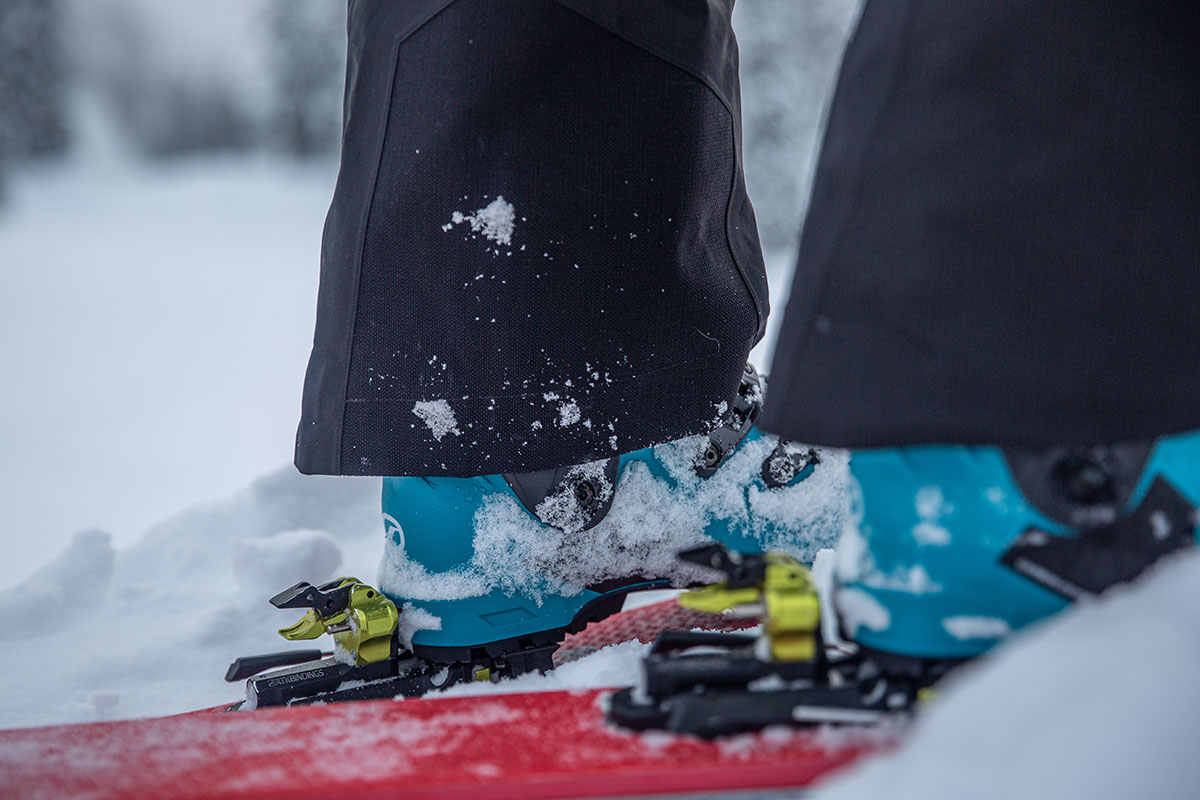
At 1 pound 6.2 ounces for my size large (listed weight is 1 lb. 6.8 oz.), the Sabre Pant lands on the lighter end of the ski pant market. For comparison, it undercuts most other 3-layer designs including Flylow Gear’s Chemical Pant (1 lb. 14 oz.), Black Diamond’s Recon Stretch Pants (1 lb. 9 oz.), and Norrøna’s Lofoten Gore-Tex Pants (1 lb. 9.3 oz.). You can shave some weight with Arc’teryx’s own Beta AR Pant (1 lb. 0.4 oz.), but that design is more of an all-rounder and a little short on ski-specific features as a result. All in all, the Sabre is light enough that I often forget I’m wearing it and have no qualms about taking it on multi-day tours.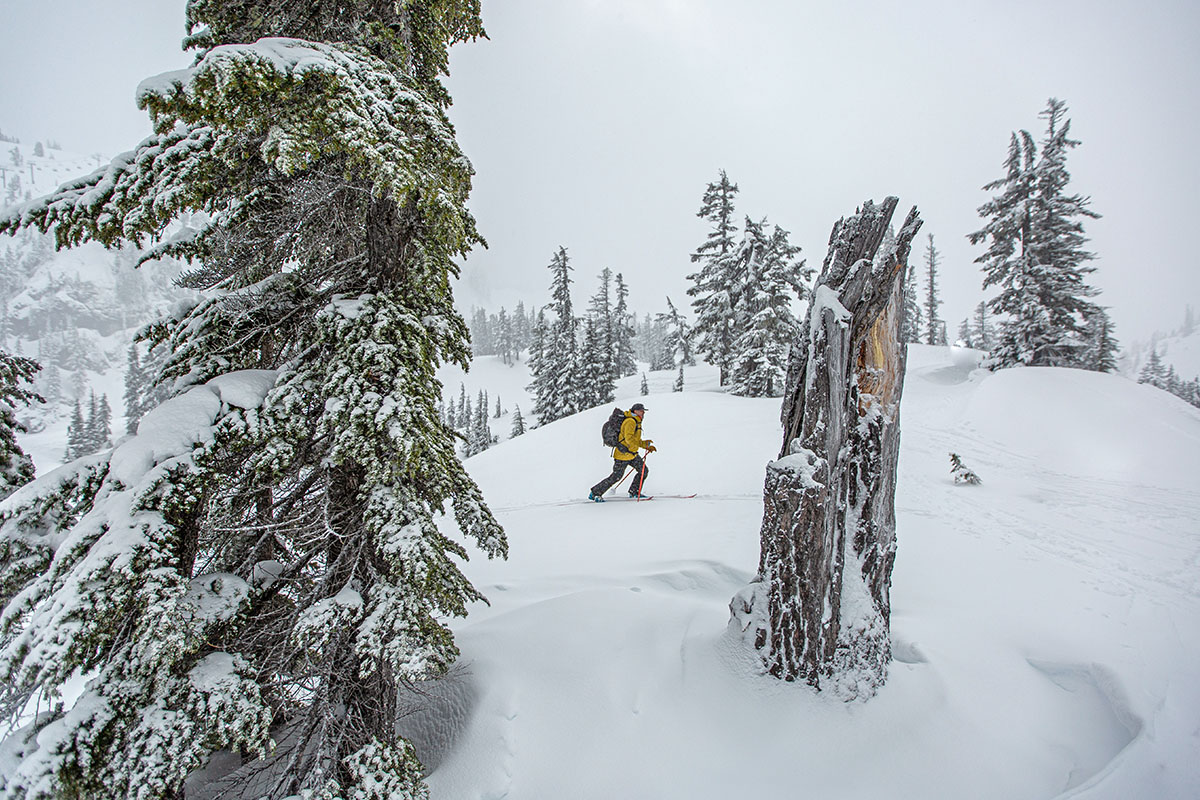
In terms of storage, the Sabre sticks to the basics with a single pocket at each thigh. They’re nicely sized for stashing gloves or a beanie, and both pockets have a small pleat on the backside that allows them to open a little farther—a small but surprisingly effective way to boost interior space. The right thigh pocket also boasts a smaller, non-zippered space for separating items like a phone, while the left pocket has a loop for attaching a set of keys. The loop could also likely work for attaching an avalanche beacon, although the pocket is on the snugger side and could potentially cause the transceiver to change modes under pressure. Instead, I prefer to wear my beacon on a harness and store my phone and/or wallet in the thigh pockets.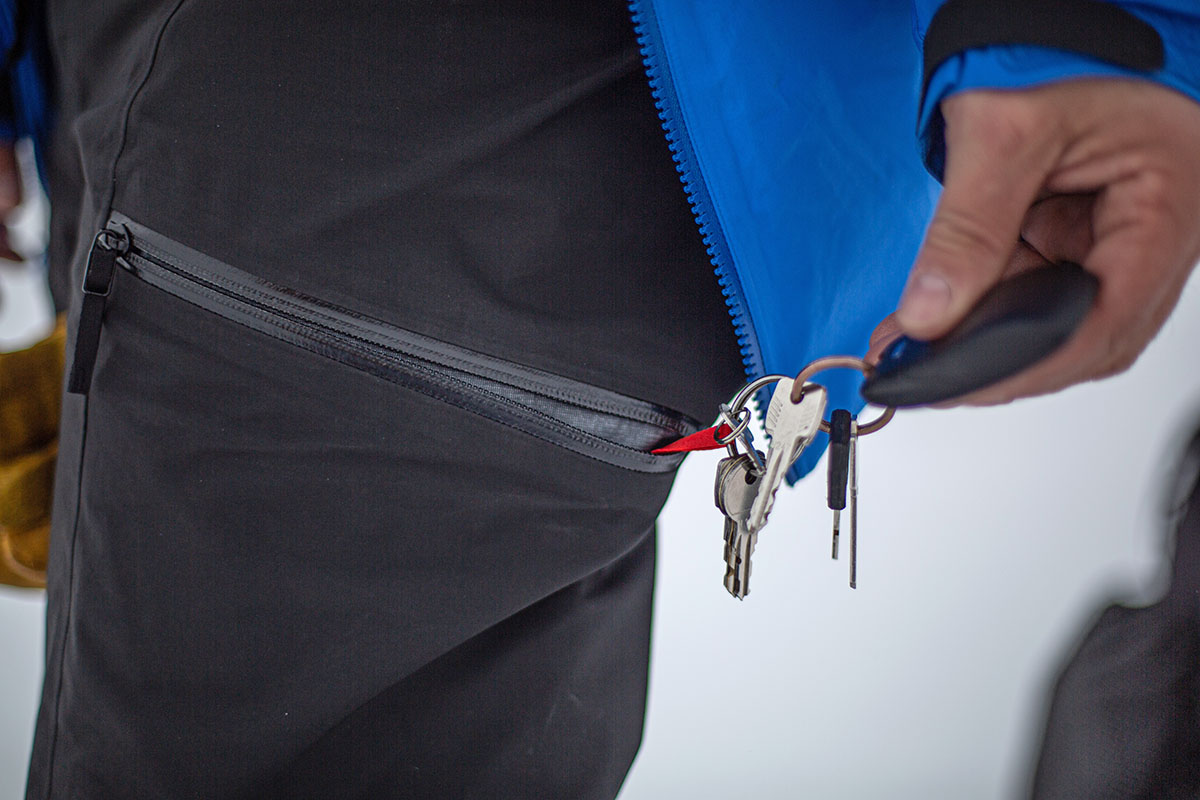
As I mentioned above, the Arc'teryx Sabre Pant comes equipped with generously sized (12-in.) vents at the outer thighs for dumping excess heat quickly. Overall, I found them to be very effective at promoting airflow and keeping me comfortable in mild weather. They’re also protected by WaterTight zippers with “garages” at the top for sealing out moisture. In practice, I’ve experienced no issues with leakage and fully trust the zippers to keep out snow and rain—even in extended and heavy precipitation. 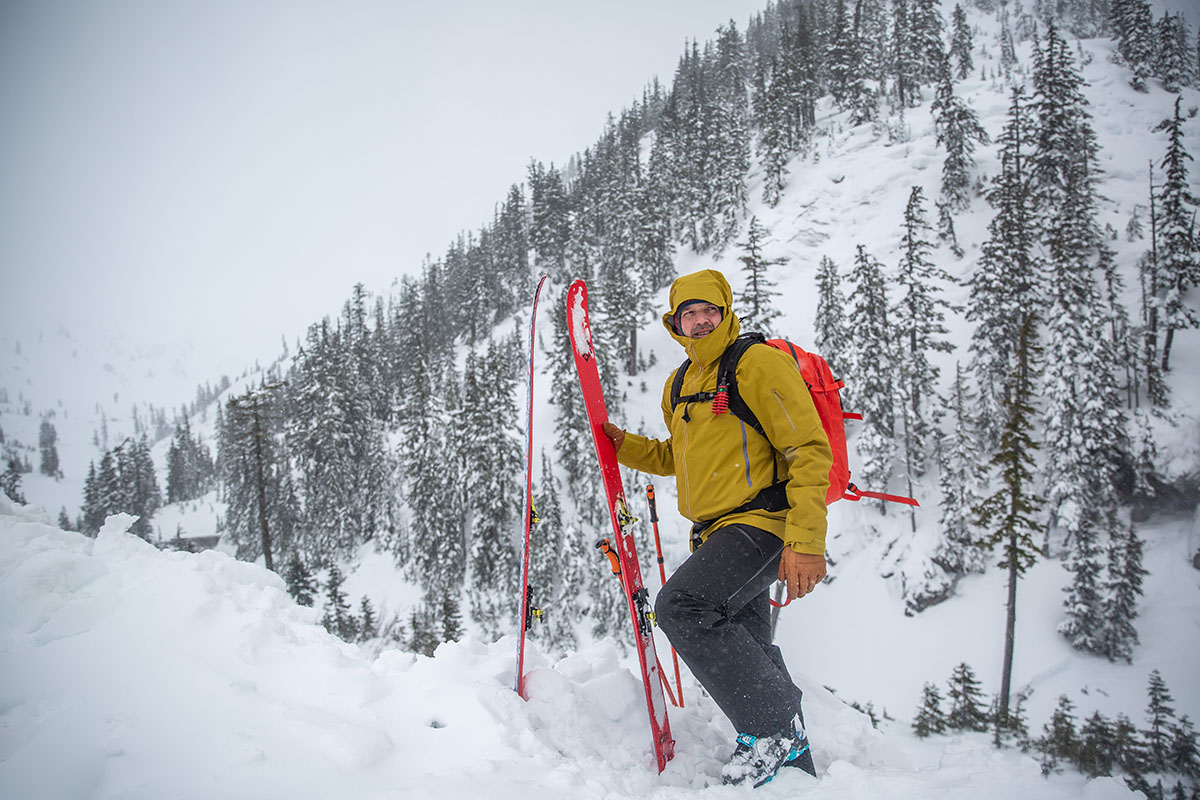
For sealing out snow at the ankles, the Sabre Pant features internal gaiters with integrated power strap slots, which Arc’teryx calls their “PowderCuffs.” While I like the idea of being able to slide my boot’s power strap through the slot to tweak fit without having to peel back the entire gaiter, it does take some time and dexterity to operate, and I usually just forgo the slot and wrap the gaiter over my boot after making adjustments. It’s worth noting that the gaiters were a little tight over my Scarpa 4-Quattro XT boots and likely would have caused some restriction over a bulkier design, but they stayed securely in place thanks to the grippy elastic and effectively sealed out snow while bootpacking and skinning, even in deep power. Importantly, they’re also noticeably beefy with 100D Cordura that’s highly resistant to tears and abrasion.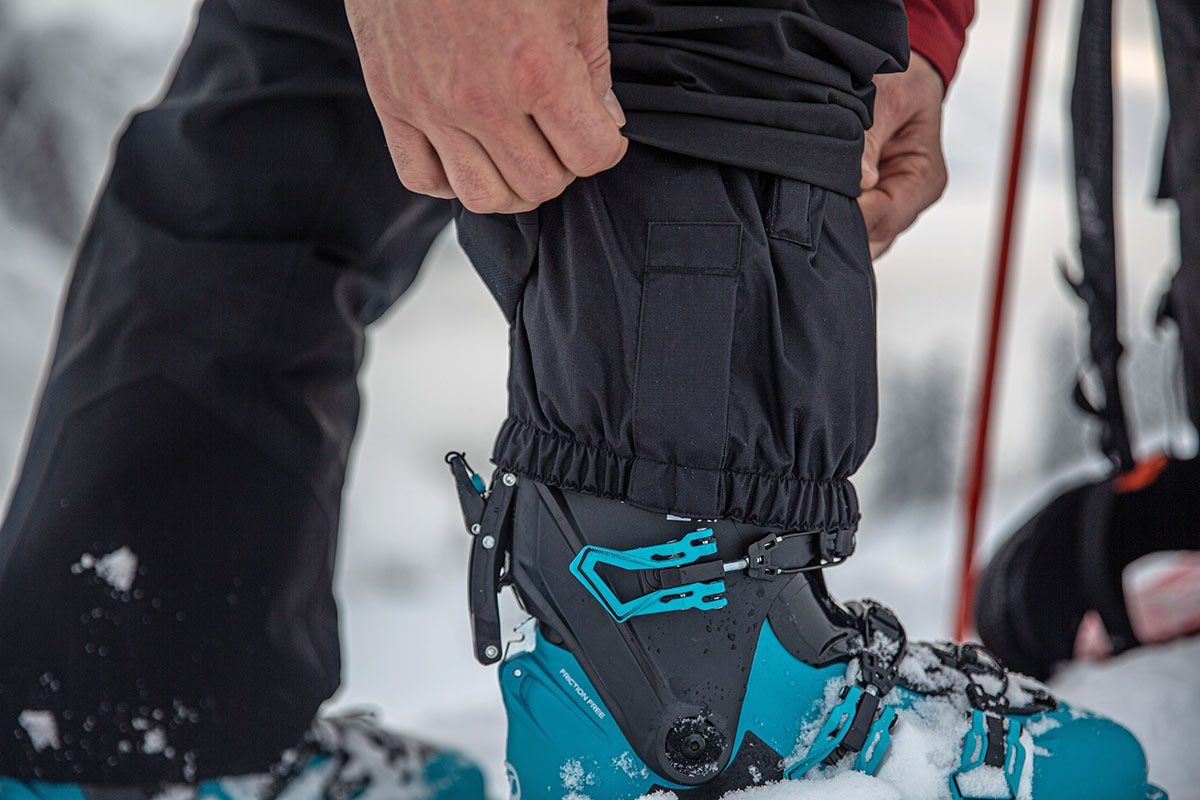
I opted for a size large and regular inseam length in the Sabre Pant—which has been my go-to size from the brand for years—but Arc’teryx’s recent fit updates proved to be a little problematic. Specifically, the pants were noticeably snug in the waist and shorter than expected both in their overall length and inseam (they felt reminiscent of low-rise jeans). In addition to the obvious reduction in comfort, this led to restriction when kneeling or bending over to tweak my boots or bindings. It also caused my long underwear to come untucked, exposing the waistband and part of my lower back. To be fair, the articulated patterning does help with overall mobility, and I appreciate that the flared cuffs leave plenty of room to accommodate ski boots. But if I had to buy the pants again, I would undoubtedly size up to an XL with a tall inseam.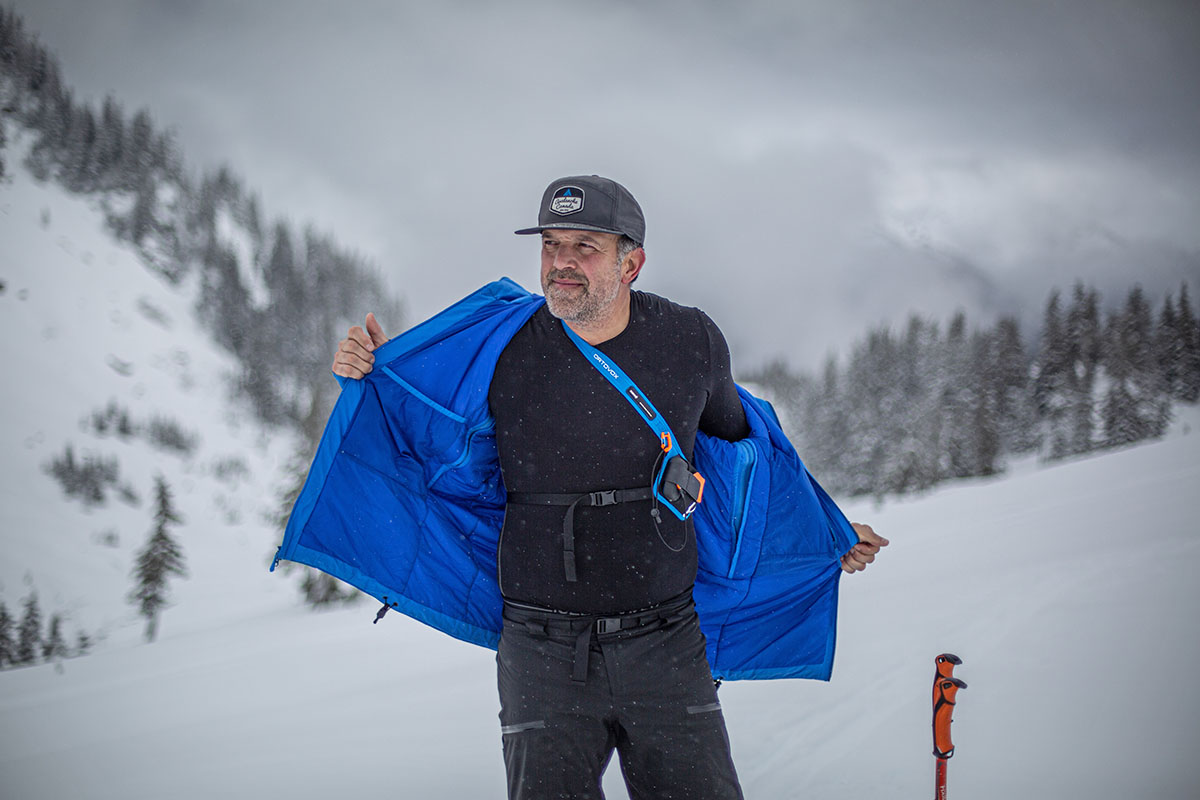
Like many leading outdoor brands, Arc’teryx has been upping their sustainability focus of late. In this case, the latest Sabre Pant uses bluesign-approved materials that are free of harmful chemicals and have been deemed safe for workers, consumers, and the environment. We’d love to see recycled fabrics and certification to the Fair Trade standard in a future update, but it’s nevertheless a step in the right direction for Arc’teryx.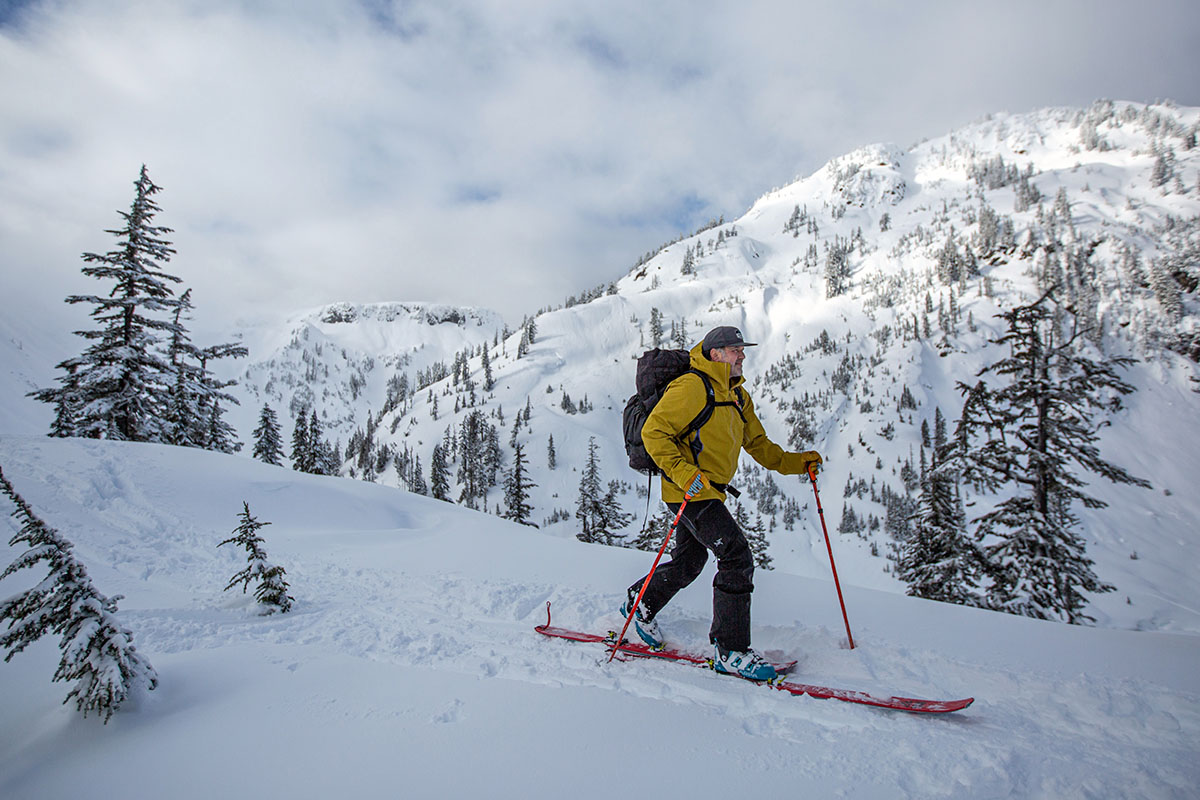
I tested the standard Sabre Pant for this review, and Arc’teryx also offers a Sabre Bib Pant for those who want the added coverage. In comparing the two, the Sabre Bib Pant costs $100 more, checks in heavier at 1 pound 9.6 ounces, and tacks on adjustable suspenders and a zippered pocket at the upper torso. To complete your kit, Arc’teryx sells the similarly well-built and versatile Sabre Jacket (see our in-depth review here), which is largely unavailable at the time of publishing but expected to come back for this upcoming winter. On the women’s side, Arc’teryx offers the equivalent Sentinel Pant, Sentinel Bib Pant, and Sentinel Jacket, as well as a few offerings unique to the women’s lineup: a one-piece design, half-zip anorak, and insulated jacket. Compared to the Sabre Pant covered here, the Sentinel Pant is lighter by a few ounces and sold in different colorways but retains an otherwise identical feature set and overall construction.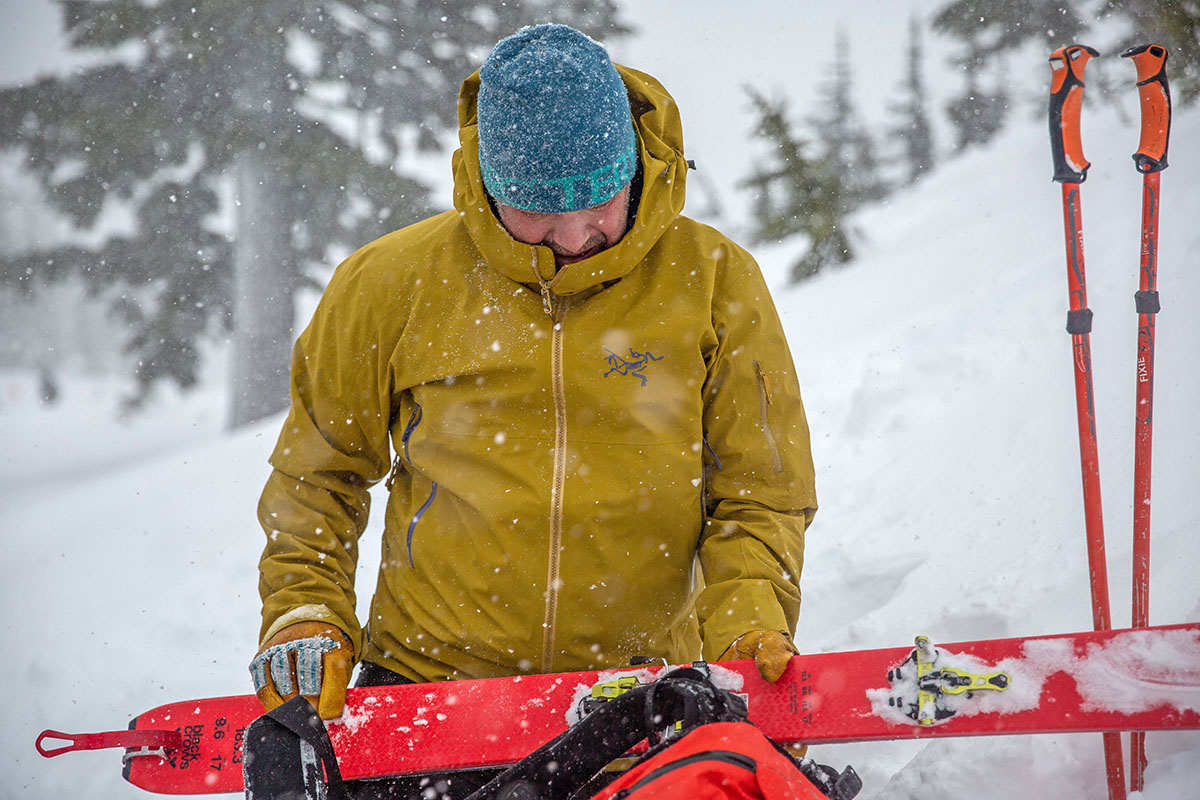
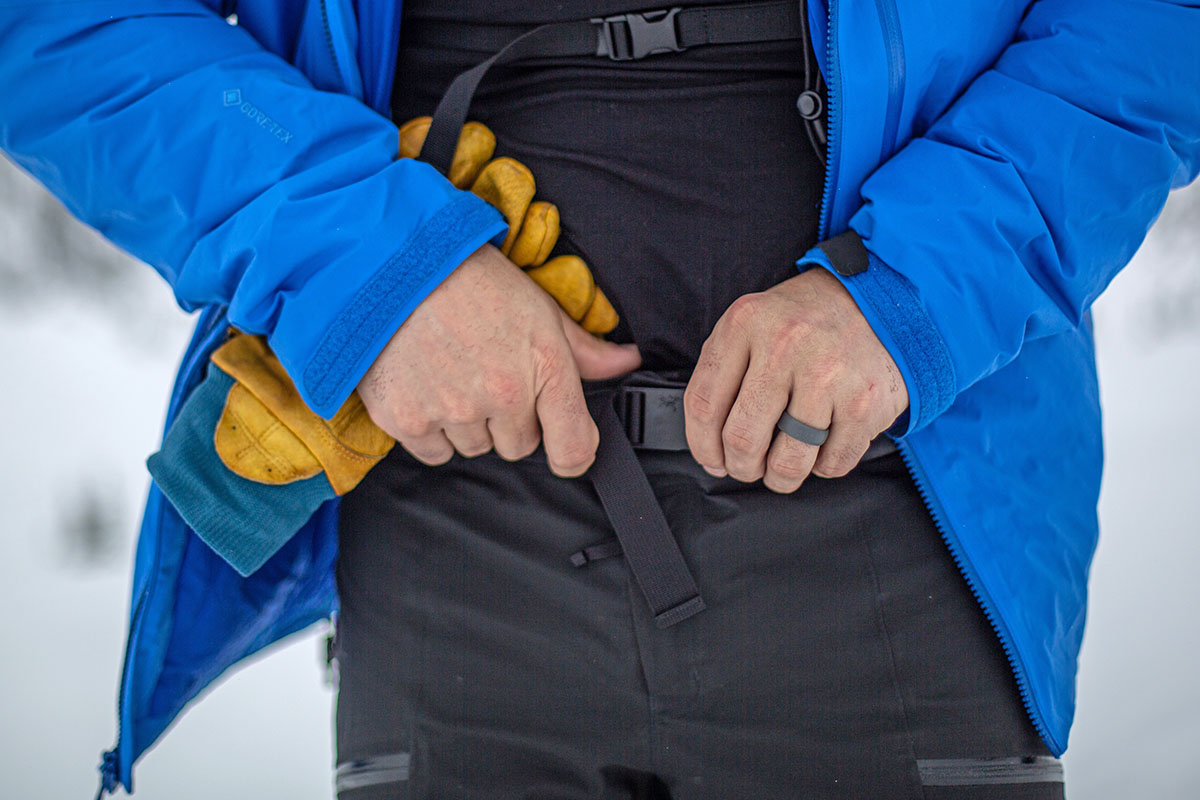
| Jacket | Price | Best For | Waterproofing | Fabric | Weight |
|---|---|---|---|---|---|
| Arc'teryx Sabre Pant | $600 | Resort/backcountry | 3L Gore-Tex | 80D | 1 lb. 6.8 oz. |
| Arc'teryx Beta AR Pant | $500 | Backcountry | 3L Gore-Tex Pro | 80D | 1 lb. 0.4 oz. |
| Norrøna Lofoten Gore-Tex | $549 | Resort/backcountry | 3L Gore-Tex w/ C-Knit | 70D x 160D | 1 lb. 9.3 oz. |
| Flylow Gear Chemical | $365 | Resort/backcountry | 3L Surface | 150D | 1 lb. 14 oz. |
| Black Diamond Recon Stretch | $350 | Backcountry/resort | 3L BD.dry | Unavail. | 1 lb. 9 oz. |
Arc’teryx’s Sabre Pant is our favorite ski pant this year thanks to its effective mix of durability, protection, and weight, but it’s certainly not the cheapest option available. For a significant $100 savings, their Beta AR Pant is another quality option with a few notable advantages over the Sabre. Highlights include a lower weight (1 lb. 0.4 oz.), upgraded Gore-Tex Pro waterproofing, and the addition of Gore’s Most Rugged technology for a boost in all-out toughness. Like the Sabre, the Beta AR also includes premium touches like 100D Cordura cuffs, abrasion-resistant Keprotec instep guards, trustworthy WaterTight zippers, and generous side zips for venting. That said, the Beta AR is more of an all-rounder than the Sabre and makes some sacrifices as a result, including a streamlined storage layout (just one zippered pocket) and an unlined build that’s relatively stiff. Some won’t mind the compromises, but the Sabre is the more specialized and better-equipped option for those looking for a dedicated ski pant. 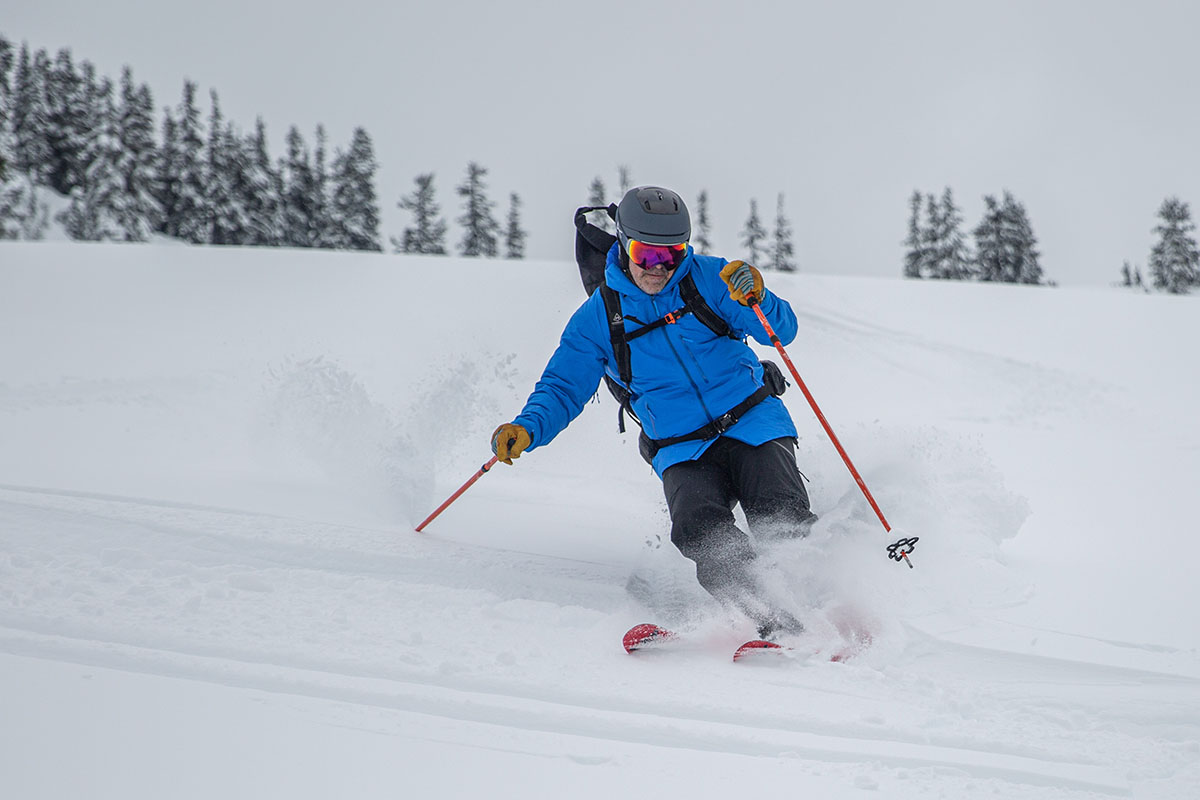
Not many brands can match Arc’teryx’s top-notch quality and attention to detail, but Norway-based Norrøna consistently gives them a run for their money. Their competitor to the Sabre is the Lofoten Gore-Tex, which is comparably priced at $549 but lines up extremely well in all-around performance. In this case, Norrøna opted for a similar 3-layer Gore-Tex build but with Gore’s soft C-Knit backer for a boost in comfort (similar to the Sabre’s flannel lining). The feature set is also very competitive, including articulated knees and a gusseted crotch for improved mobility, three pockets that are protected by water-resistant zippers, integrated gaiters, reinforced patches at the ankles, side zips for venting, and compatibility with a powder skirt and suspenders. However, the Lofoten is heavier at 1 pound 9.3 ounces and has a noticeably bulkier look and feel, which is enough for us to give the Arc’teryx the edge—especially for those who frequent the backcountry.
Next up is Flylow Gear’s Chemical Pant, which offers a similarly competitive mix of toughness and protection. Rather than Gore-Tex, Flylow opted for an in-house 3-layer design that’s noticeably thick (150D) and very trustworthy in rough weather, and we appreciate that you can release hot air in four places: two zippered vents at the inner thigh and two large vents along the outside. You also get burly cuff reinforcements, full seam taping, three total pockets (one of which has a beacon clip), powder cuffs, thick Cordura patches at the knees, and fully waterproof zippers. However, with all this ruggedness comes a bump in weight—at 1 pound 14 ounces, the Chemical is a considerable 7.2 ounces heavier than the Sabre without enough to show for it. Occasional resort-goers may be swayed by the $365 price tag, but dedicated riders who spend time both in- and out-of-bounds will benefit by spending up for the Arc’teryx.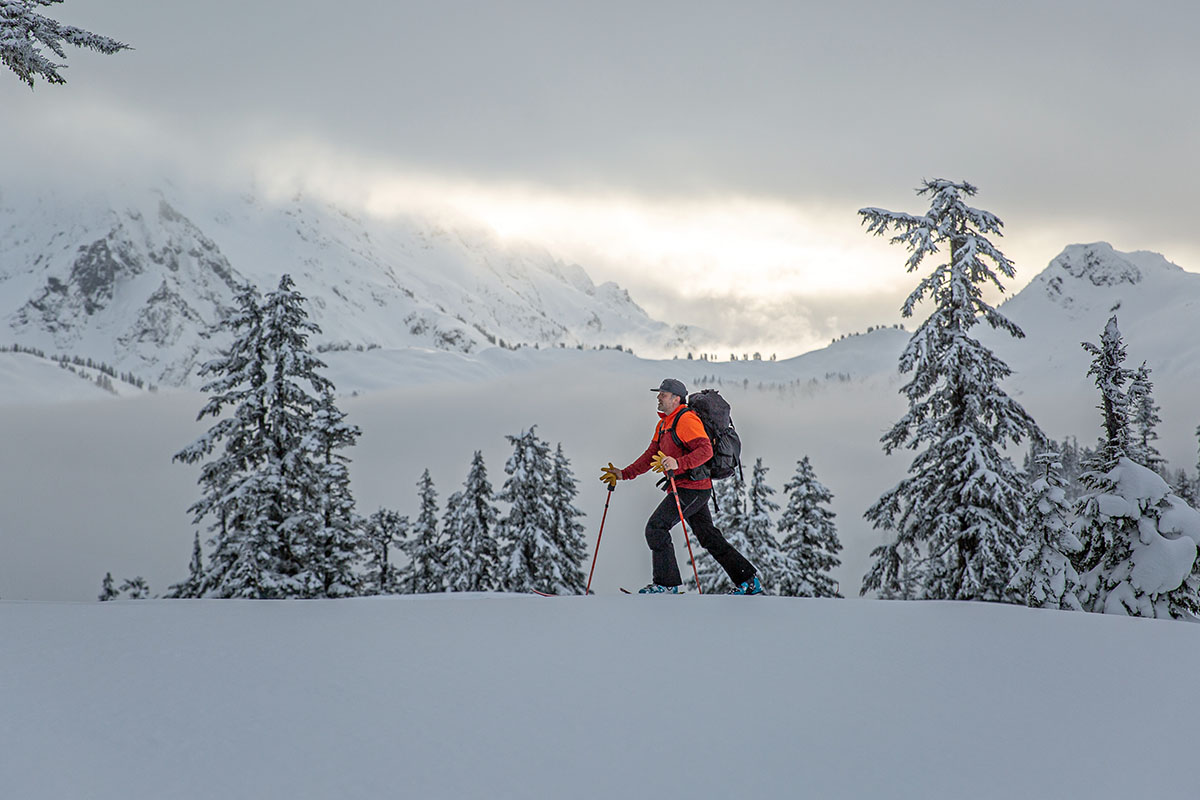
Last but not least is Black Diamond’s Recon Stretch, which is the cheapest alternative here at $350. Right away, we’ll note that the Recon is heavier than the Sabre at 1 pound 9 ounces and a step down in both weather protection and durability, but there’s still a lot to like. Namely, the pants put a clear focus on comfort and mobility with a woven softshell-like face fabric and smooth jersey backer, and BD included key features like easily accessible side vents, two thigh pockets, internal gaiters, reinforced instep patches, and a built-in Recco reflector. Again, the Sabre is the tougher and more protective design for especially wet climates, but the BD is trustworthy enough to rely on in most conditions and a nice value for those willing to take some extra care around sharp equipment.
If you’re thinking about buying gear that we’ve reviewed on Switchback Travel, you can help support us in the process. Just click on any of the seller links above, and if you make a purchase, we receive a small percentage of the transaction. The cost of the product is the same to you but this helps us continue to test and write about outdoor gear. Thanks and we appreciate your support!
Depending on the seller, most products ship free in the United States on orders of $50 or more. International shipping availability and rates vary by seller. The pricing information on this page is updated hourly but we are not responsible for inaccuracies.